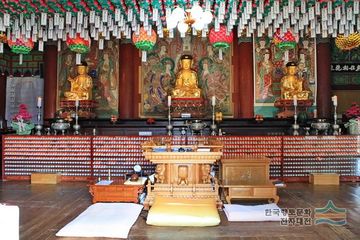"천안 광덕사 삼세불도"의 두 판 사이의 차이
Mkichukova (토론 | 기여) (→영문) |
Mkichukova (토론 | 기여) (→영문) |
||
| 36번째 줄: | 36번째 줄: | ||
'''Three World Buddhas of Gwangdeoksa Temple, Cheonan''' | '''Three World Buddhas of Gwangdeoksa Temple, Cheonan''' | ||
| − | + | Three World Buddhas enshrined in Daeungjeon Hall of Gwangdeoksa Temple depict Sakyamuni (the historical Buddha), Amitabha (the Buddha of the Western Paradise), and Bhaisajyaguru (the Medicine Buddha). Sakyamuni is the buddha of the here and now, Bhaisajyaguru is the buddha of the east and past, and Amitabha is the buddha of the west and future. | |
According to a record remaining on the painting, it was made in 1741 by several monk painters, namely Bungu, Sahye, and Inchal, and it was housed at Gwangdeoksa Temple. Originally, it was painted on three pieces (of cloth?), with one piece each hung behind Wooden Seated Sakyamuni Buddha Triad (Chungcheongnam-do Tangible Cultural Heritage), but in 1991, the painting which was once hung behind the image of Bhaisajyaguru, sitting on the right, was stolen, so currently, a painting painted anew afterward is hung. | According to a record remaining on the painting, it was made in 1741 by several monk painters, namely Bungu, Sahye, and Inchal, and it was housed at Gwangdeoksa Temple. Originally, it was painted on three pieces (of cloth?), with one piece each hung behind Wooden Seated Sakyamuni Buddha Triad (Chungcheongnam-do Tangible Cultural Heritage), but in 1991, the painting which was once hung behind the image of Bhaisajyaguru, sitting on the right, was stolen, so currently, a painting painted anew afterward is hung. | ||
2022년 11월 18일 (금) 07:38 판
| 천안 광덕사 삼세불도 |
|
 천안 광덕사 삼세불도, 디지털천안문화대전, 한국학중앙연구원. |
|
| 대표명칭 | 천안 광덕사 삼세불도 |
|---|---|
| 한자 | 天安 廣德寺 三世佛圖 |
| 주소 | 충청남도 천안시 동남구 광덕사길 30 (광덕리) |
| 지정번호 | 충청남도 유형문화재 제190호 |
| 지정일 | 2007년 10월 30일 |
| 분류 | 유물/불교회화/탱화/불도 |
| 시대 | 조선시대 |
| 수량/면적 | 2점 |
| 웹사이트 | 천안 광덕사 삼세불도, 국가문화유산포털, 문화재청. |
해설문
국문
삼세불도는 석가여래, 아미타여래, 약사여래를 함께 그림으로 그린 것으로, 조선 초기부터 조성되기 시작하여 다수의 조선후기 작품이 사찰에 남아 있다. 대상이 되는 삼세불은 약사여래(과거_동방), 석가여래(현재), 아미타여래(미래_서방)로 시간적 ․ 공간적인 삼세의 부처님을 의미한다.
천안 광덕사 삼세불도는 석가여래(영산회상도), 아미타여래(아미타회상도), 약사여래(약사회상도)의 3폭으로 구성되어 있으며, 마 바탕에 채색하여 그린 것이다. 1991년에 약사회상도가 도난되어 현재는 영산회상도와 아미타회상도 2점만 남아 있으며, 대웅전 내부 불단 위에 봉안되어 있다.
영산회상도는 본존인 석가여래를 중심으로 8대 보살과 사천왕, 10대 제자 등 다수의 권속들이 좌우 대칭 형태로 배치되어 있다. 반면에 아미타회상도는 영산회상도에 비해 권속의 수도 적고 단순한 구도를 보여준다.
천안 광덕사 삼세불도는 화기(畫記)에 적힌 “건륭6년신유6월일(乾隆六年辛酉四月日)” 이라는 내용을 통해 1741년에 제작하여 광덕사에 봉안했음을 알 수 있다. 또 당시 불화 조성에 참여한 화승으로는 붕우(鵬友) 사혜(思惠), 인찰(印察) 등이 기록되어 있다.
한 점을 도난당하여 2점만 남아 있지만 안정된 구도와 원만한 인물표현, 유려한 필선, 뛰어난 채색 등을 통해 18세기 전반 불화의 형식을 잘 보여주고 있어 가치가 높다.
영문
Three World Buddhas of Gwangdeoksa Temple, Cheonan
Three World Buddhas enshrined in Daeungjeon Hall of Gwangdeoksa Temple depict Sakyamuni (the historical Buddha), Amitabha (the Buddha of the Western Paradise), and Bhaisajyaguru (the Medicine Buddha). Sakyamuni is the buddha of the here and now, Bhaisajyaguru is the buddha of the east and past, and Amitabha is the buddha of the west and future.
According to a record remaining on the painting, it was made in 1741 by several monk painters, namely Bungu, Sahye, and Inchal, and it was housed at Gwangdeoksa Temple. Originally, it was painted on three pieces (of cloth?), with one piece each hung behind Wooden Seated Sakyamuni Buddha Triad (Chungcheongnam-do Tangible Cultural Heritage), but in 1991, the painting which was once hung behind the image of Bhaisajyaguru, sitting on the right, was stolen, so currently, a painting painted anew afterward is hung.
The Vulture Peak Assembly, hung behind the statue of Sakyamuni in the middle, depicts the scene of the Buddha’s lecture at Vulture Peak. Entourages such as eight bodhisattvas, Four Guardian Kings, and ten disciples are situated at a bilateral symmetrical layout with Sakyamuni at the center. The painting hung behind Amitabha Buddha to the left depicts the scene of Amitabha Buddha’s lecture in the Western Paradise and compared to the Vulture Peak Assembly, it displays a small number of entourage and a simple composition.
Although one was stolen, the style of Buddhist paintings of the 18th century is displayed well through balanced composition, favorable faces, smooth brushwork, and excellent colors, having great value.
영문 해설 내용
광덕사 대웅전에 모셔진 삼세불도는 석가여래, 아미타여래, 약사여래를 그린 것이다. 석가여래는 이 세계의 부처이면서 현세불이고, 약사여래는 동방(東方)의 부처이면서 과거불이며, 아미타여래는 서방(西方)의 부처이면서 미래불이다.
그림에 남겨진 기록에 따르면 1741년 붕우, 사혜, 인찰 등의 화승이 참여해 제작하고 광덕사에 봉안하였다. 원래 총 3폭으로 그려져 목조석가여래삼불좌상(충청남도 유형문화재) 뒤에 한 폭씩 걸려 있었는데, 1991년 오른쪽 약사여래상 뒤에 걸려 있던 그림이 도난되었고, 지금은 후대에 새로 그려진 그림이 걸려 있다.
가운데 석가여래상 뒤에 걸린 영산회상도는 석가여래가 영취산에서 설법하는 장면을 그렸다. 석가여래를 중심으로 8대 보살, 사천왕, 10대 제자 등의 권속들이 좌우 대칭 형태로 배치되어 있다. 왼쪽 아미타불 뒤에 걸린 그림은 아미타불이 극락세계에서 설법하는 장면을 표현하였으며, 영산회상도에 비해 권속의 수도 적고 단순한 구도를 보여준다.
비록 한 점을 도난 당하였지만, 안정된 구도, 원만한 인물표현, 유려한 필선, 뛰어난 채색 등을 통해 18세기 불화의 형식을 잘 보여주고 있어 가치가 높다.
참고자료
- “[기획칼럼] 사찰의 아픈 기억 사라진 불화”, 충남도정신문 기획칼럼, 충청남도역사문화연구원. https://cihc.or.kr/kor/BBSMSTR_000000000256/3888/view.do